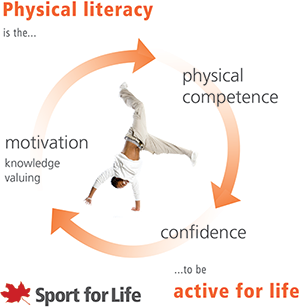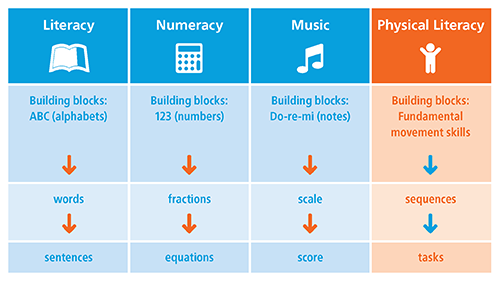Physical Literacy
Physical literacy is the development of fundamental movement skills that are needed for daily activities, physical activity, sport and movement. Physical literacy is essential for children’s optimal growth and development. It sets the path for a life-long relationship with physical activity, learning new skills, and good physical and mental health. Although physical literacy can be developed at any stage in life, it is best to start early because intensive brain development forming the critical neural connections occurs in the first five years of life.
Video: Learning to be active at a young age is extremely important because active kids become active adults – who are positive role models.
What is physical literacy?
Physical literacy:
- Is the motivation, confidence, physical competence, knowledge and understanding to value and take responsibility for engagement in physical activity for life (Canada’s Physical Literacy Consensus Statement, June 2015)
- Is the development of fundamental movement skills that allow individuals to move with competence and confidence in a wide variety of activities that benefit the healthy development of the whole person
- Includes an individual’s ability to “read” what is going on around them in an activity setting and react appropriately (Physical and Health Education Canada)

Fundamental movement skills
Fundamental movement skills are basic movements on land, in the air, in the water and on ice or snow that involve various body parts. These movement skills form the basis of physical literacy and need to be learned and practiced by children to build competence in their movements and confidence in their abilities.
Fundamental movement skills include:
- Locomotor skills that enable moving through space, such as walking, running, jumping, hopping, skipping, swimming, skating and climbing
- Non-locomotor skills, such as balance and stretching
- Skills that enable manipulation of objects, such as throwing, catching, hitting, kicking and dribbling
Why is physical literacy important?
Physical literacy is as important to children as reading literacy, numeracy and music. It is the gateway to physical activity.

Due to increased screen time and lack of physical activity, there is an increase in obesity, a decrease in fitness in children and an increase in the risk for chronic diseases later in life, such as diabetes, heart disease, stroke, some cancers, osteoporosis and depression.
With physical literacy, children will have competence and confidence to participate in a variety of physical activities and settings. They will progress to more complex skills used in sports, leisure activities and vocations, and continue to be active throughout their life. Also, they are more likely to make healthy lifestyle choices.
The Development of Physical Literacy
Kids develop physical literacy gradually.
- From birth to age three: encourage early movement
- Between ages three and five: expand on play and keep it fun
- Between ages five and eight: increase the focus on fundamental movement skills
- Between ages eight and 12: introduce more complex skills as kids are ready
Adapted from ActiveforLife.com
Children who are physically active are likely to:
- Be ready to learn and do better in school
- Be healthy and more fit
- Have healthier body weight
- Have stronger bones and muscles, hand-eye coordination and good posture
- Have better sleeping patterns, reduced anxiety and depression
- Develop emotional maturity
- Feel good about themselves
- Have better social skills and leadership abilities
- Stay away from unhealthy habits
- Enjoy physical activity and stay active for life
- Achieve personal success
What can you do to enhance physical literacy in children?
As an educator (teachers, coaches, early childhood educators, etc.):
- Be positive role models
- Provide opportunities for children to develop and practice the fundamental movement skills including use of nature and outdoor play
- Encourage children to move and positively reinforce their efforts. Allow children to guide activities based on their interests and building on their ideas
- Ensure children have ample rest between activities
- Facilitate activities that use a wide variety of fundamental movement skills
- Model and encourage determination as they learn new and challenging movements
- Promote the building of children’s resilience and critical thinking by facilitating the use of learned skills in new and exciting environments
- Modify activities for children of differing developmental abilities
- Foster an environment that supports learning through practice and ensures children can regulate their emotions, behaviour and attention in order to cope with the demands of their situation
- Support children in learning self-regulation during play so they can improve their ability to self-regulate in more challenging environments
Physical Literacy Handbook for Early Childhood Educators
As a parent:
- Be positive active role models
- Provide opportunities for children to develop and practice fundamental movement skills
- Spend time to play together with your children. This will improve the bonding with your children
- Coach your children on fundamental movement skills, praising them for success
- Provide children with options for play, observing and listening to how they have fun
- Ensure that children take ample rest between activities
- Encourage outdoor active play
- Encourage children to take part in a variety of activities and sports until they have developed confidence and skills rather than specializing in one sport or participating in competitive sports early in life
- Ensure that children get sufficient sleep so they can be refreshed and alert the next day: 11 to 14 hours for toddlers, 10 to 13 hours for preschoolers and 9 to 11 hours for school age children (Source: The Sleep Foundation)
Related Resources
External Resources
- Canadian Sport for Life
- Developing Physical Literacy: A guide for parents of children ages 0 to12 (Canadian Sport for Life)
- Active for Life
- Markham in Motion (City of Markham)
- Physical & Health Education Canada - Physical Literacy
- Fundamental movement skills tools – assess me and show me videos
- Video: Ophea Canada: Hands Up – Part 1: Introduction to Physical & Health Literacy
- Passport for Life


